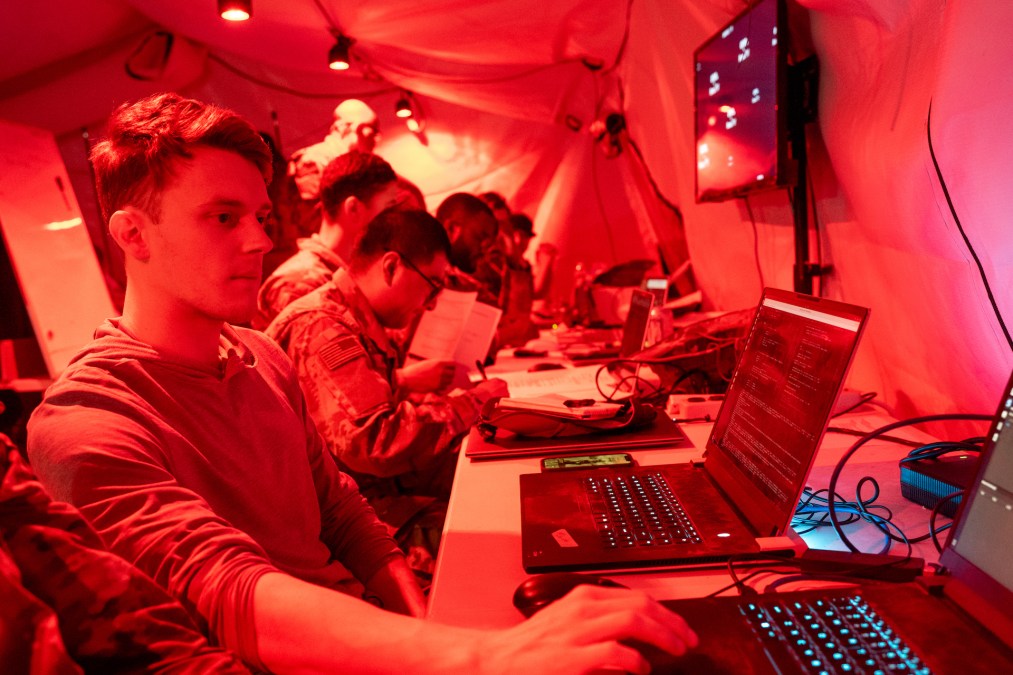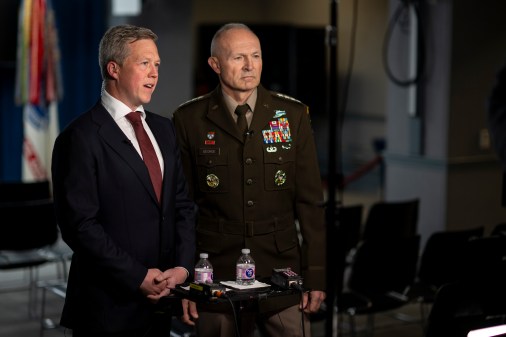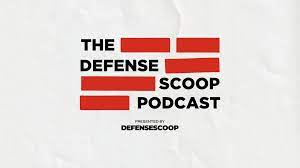Army plans big shakeup in software buying practices, starting with new $10B enterprise deal with Palantir

A new enterprise agreement with Palantir that the Army announced on Thursday is just the beginning of a larger push by the service to gain more flexibility and transparency in how it buys software and be a better steward of taxpayer dollars.
Ahead of the announcement, Army officials told reporters that they’re looking to change the software buying model.
“The direction we’re moving in right now in the Army is this is going to be one of many enterprise licensing agreements that we’re looking at entering into,” Army Chief Information Officer Leonel Garciga told a small group of reporters ahead of the announcement. “I think the big thing to think about is, as kind of we move forward, we’re finding some things, we have a lot of big software packages that are out there. They’ve been bought over several years, several program offices, several commands, [but we’re] not getting a lot of parity across the board on how they’re being delivered, right? Adding a lot of complexity to the environment. And we’ve been thinking through a couple things, right? One is, how do we reduce the complexity, right? So lower overhead to acquire capability, especially software. That’s kind of the first kind of tenet.”
The next piece, he said, is to figure out how to “make it a lot easier to acquire said software, right?”
“I think the traditional model of, hey, we’re just buying software licenses and services … in combos kind of doesn’t work in this new environment and the way that things are being delivered,” Garciga said. “So how do we add enough fidelity, right, and an approach where folks can really get the software the way they need it?”
The final piece, one that Garciga said he as the Army CIO cares “very much about,” is reducing cost. “How do we get better buying power across the board?” he said.
The 10-year deal with Palantir is worth up to $10 billion, although Army officials noted that they’re not committed to spending that much money. The move will consolidate 75 contract vehicles as the Army looks to streamline things, they said.
“This really has been our first kind of separate sense to go in and really get a large ELA. This is one of many. But our intent is to continue to move down this path, right, to really focus on reducing that complexity, adding agility to how we buy, right, and then the last piece … which is save taxpayer dollars as much as we can,” Garciga said.
The service is in talks with other vendors for similar types of arrangements.
“We have a couple of others that are teed up that we’re either already in negotiation with or starting the conversation to start negotiations with to do this across the board,” Garciga said.
A key aim of the initiative is to get better deals from a unit cost perspective. In the civilian side of the federal government, the General Services Administration is leading a similar effort to maximize government buying power for software licenses called OneGov.
“What I see across contracts is, hey, if I have more than one contract with the same vendor, have I bought the same thing more than once in a different way or at a different price? And just from a common-sense perspective, does that really make sense?” Danielle Moyer, executive director of Army Contracting Command, told reporters.
“Starting with Palantir and as we look at other ones, we’re looking at, hey, it makes sense to make sure … we’re getting the best discounts. So just like economies of scale buy, right? If I buy one widget, it costs X amount. If I buy 100, I should get a discount. And the more I buy at scale, the more of a discount I should [get]. And also … just in general, across this whole initiative, we’ll look at, well, how are you selling this elsewhere? Should there be clauses in the contract that say, hey, you know, if you try and sell it somewhere else, we need to come back here and look at what the rate is on this and get a discount,” Moyer said.
She noted that the Army isn’t actually obligating $10 billion to Palantir, but the deal recognizes potential growth for the services and goods that are on that contract with the multibillion-dollar ceiling. While there is a minimum spend requirement on the contracts, the Army has no obligation to buy more than it sees fit across its enterprise.
The Army is also trying to avoid vendor lock as it shakes up its buying practices.
“The other really important thing to note there is competition for future programs and things like that will still continue to happen. So, for example, if on all these ELAs — name the vendor — if we’re specifically talking about Palantir, if Palantir chooses to compete on, you know, whatever program or weapon system in there, the chosen awardee they happen to be at, then we would obviously leverage this agreement [to get] economies of scale discounts, buys, right, that makes the volume,” Moyer said. “We would leverage our buying power in the Army to get maximum discounts. So those are probably, from a contracting perspective, the things that … we really want to make sure that we hit home, which is robust competition is still a thing.”
The Army also wants to make sure it doesn’t overbuy and acquire licenses it doesn’t need.
Officials used a food analogy, comparing previous software buying practices to all-you-can-eat buffets or combo deals where customers essentially pay for things they might not consume.
“As we look at the way we’ve done kind of historical contracting … we typically will, kind of sometimes overbuy, because we’re trying to kind of calculate what expected growth is and whatnot. So this [enterprise agreement] is meant to help shape that, to say we’re buying just in time into that growth pattern, right? So, instead of saying, OK, I need 100 licenses, I only have to buy 50 now based on the real usage versus buy 100 because that’s where we have to fix a contract that’s meant to be for a longer period of time. So shifting that mentality is to say, OK, now we could just do just in time, kind of delivery of services,” Gabe Chiulli, chief technology officer for Army’s Enterprise Cloud Management Agency, told reporters.
Officials want a more flexible range of options, sort of like an a la carte menu where they can just pick exactly what they want.
Garciga said early efforts to set the stage for the new model began during the previous administration, but he suggested that the focus on improving software acquisition at the Defense Department under the Trump administration has provided additional momentum.
“We have been working on this since November of last year. And I think that there was just an inherent understanding, you know, almost two years ago now that we needed to start moving in this direction with a handful of our vendors,” he said. “There’s been a lot of prep work and foundation being laid to have this conversation. If anything, what I’d say is the change in the environment has allowed us to move a little bit faster than we would have normally, and I think, a willing acceptance by a lot of our commercial partners to rethink the way that they integrate and work with us in the government and what our contractual agreements are going to look like moving forward. So I think … we’ve had a little bit of a catalyst over the last like quarter and a half that’s just be able to get this like really over the hump, to get a really good deal for the Army.”
Moyer said the new way of doing things will also improve transparency into what the Army is buying.
“It’s easy [to keep track] when you buy things that you can see, right? When you buy a tank, right, you can probably see the brand of the wheels on it. It’s pretty, pretty easy. Well, when you build, you know, a weapon system that might have some software in it, and that software vendor — name the vendor — is a subcontractor, we don’t always have visibility on who those are. So I think this initiative in general will provide us visibility into how often are we buying the same software that is essentially a component or a subcontractor through somebody else,” Moyer told reporters.
The Army, as a huge organization that buys a ton of software, should be able to get better deals, Garciga suggested.
“When I look across the landscape, there’s … both software and hardware procurements that we’re doing out there with major IT companies where it would be advantageous to get an enterprise agreement just to get value at scale, right? I mean, think [about] the Army [having] 1.3 million people, right? I mean, we’ve got more endpoints than some countries do,” he said.

The Army is also looking to prevent middlemen from jacking up costs for software.
“What the enterprise agreement allows us to do is to get a much better kind of understanding when we do actually compete new work on what some of those baseline costs are going to be, because we’re kind of making it so folks have to use the enterprise agreement to buy the software, as opposed to what we’ve seen traditionally, which is like, hey, somebody’s going to go out buy this, and then a company is going to go buy it … and bump our cost up considerably for the same piece of software at scale. So I think our intent, like from especially from the CIO’s office, is to focus on where we have a considerable amount of use across Army commands and Army programs, can we engage with those companies to get value at scale, right, and in no way to get in the way of competition,” Garciga said.
ELAs are also seen as a way to help the Army keep pace with fast-moving software developments.
“We don’t want to be in the business of just buying this big block of software and then, you know, three years from now, we’re trying to figure out how to modernize that. No, on the contrary, I think this puts us in a much better position to be able to get that refresh happening organically from the commercial space. And again, it’s about flexibility too, right? It’s having that CLIN [contract line item number] structure that really allows us to as things grow and shrink, have the opportunity to adjust those levers and those rheostats to get us to kind of a baseline,” Garciga said.
He continued: “The next big step, right, and I think we’re going to see this with a lot of our vendors, is this idea of, like, hardware as a service and hardware subscriptions. I think we’re going to see that come in, too. That’s one that we’re working especially for fixed and garrison locations, is where do we have opportunities to rethink where traditionally we’ve done bulk buys and then, you know, five years later, we’re trying to figure out why we can’t lifecycle maintenance it. Now we’re going to kind of as a service, right? And we’ll work with the vendor to make sure that happens. But on the software side, yeah, definitely this is a lot easier.”
Moyer said under the enterprise agreement framework, the Army would be in a position to negotiate better deals over time.
“The other thing that you know we’re working across all the enterprise agreements we’re looking at is, once we get to X number every year … then we’re going to potentially negotiate on all these either A, a true up, or B, a discount for the next year,” she said.
Garciga noted that in the past, the Army has sometimes lost the space to negotiate.
“What we’re seeing right now is, how do you build a vehicle that allows you to … true up, true down, right as the environment changes?” he told reporters. “The larger we get, the bigger the discount. And we may be here for, like, you know, X amount, and then, you know, if we go to the next level up, we’ll get an even bigger discount, right? So I think that that’s going to be the big thing, is continuing that negotiation.”
Another important aspect of the enterprise agreement framework is that it will give the Army flexibility to jump around from a capability-acquisition perspective, he noted.
“If we want to move to the next major … platform that we want to do an enterprise agreement with, and we want to get off the one we’re on, we can gracefully exit that without having kind of put a lot of capital in front that we can’t recover,” Garciga said.
Moyer said the enterprise agreements will have minimum guarantees.
“Once you meet that, you don’t ever have to use that contract again. So if any point it doesn’t make sense … to use that vehicle, there’s somebody different or better, we could always do something different,” she told DefenseScoop. “But … just using my own common sense, why wouldn’t I try and get the best deal for as long as possible and write things in there like maximum discount buys, matching commercial prices, right? So, like, not necessarily for this specific EA, but just a general EA.”
There are many vendors out there that the Army could have enterprise agreements with, officials told DefenseScoop. And, there could be opportunities for the other services or DOD writ large to pursue these types of agreements.
“The service CIOs are all talking and we’re talking with DOD CIO,” Garciga told DefenseScoop. “If you’re already a year into your negotiation, like, we’re gonna put our requirements in and you finish up. If we’re a year into our negotiation and we’re like about to award, like, hey, we’ll get your requirements agreement. So I think we’re really at this point, I think the whole department is really pushing harder to move in this direction. So this [deal with Palantir] is just one of our first off the chute kind of big ones.”
The other services could potentially piggyback off the Army.
“There are discussions that are currently ongoing and … they’ll figure out what makes sense for them,” Moyer told DefenseScoop. “But we will position ourselves to make sure that, you know, if we can use taxpayer dollars in the most efficient way possible to get the biggest discount for any of these enterprise agreements we’re working, that is what we’re going to do.”






